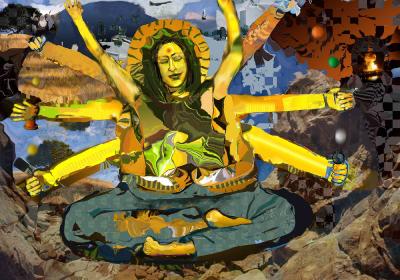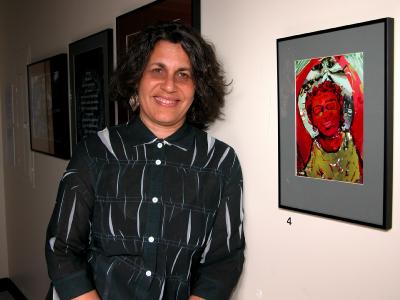November 4, 2004
Tacoma prof left New York seeking to raise consciousness
|
In her 20s, Beverly Naidus was an up-and-coming New York exhibition artist with a reputation for socially effective work and a bright future. But poised on the brink of success, she looked around and decided to walk away. It was a choice that would shape her future as an art educator.
“I saw my friends in the art world develop these jet-setting careers,” said Naidus, now an art instructor in the Interdisiciplinary Arts and Sciences department at UW Tacoma. “I didn’t want that. I wanted to use my art to raise consciousness.”
So Naidus turned the page on what she calls the “New York art world chapter” of her life and began writing a new one as a respected teacher of art that influences the world. She calls it “art for social change,” and inspires her students — experienced artists and novices alike — to use paint, pencils, computers and themselves to make a difference.
“My goal is to get people to recognize that art isn’t about decorating the walls of your home,” she said. “Art can raise consciousness or tell a story or a truth that you don’t see portrayed in pop culture or the media. Art has a function that’s about more than beauty.”
Naidus came to UWT from Goddard College in Vermont, an “experimental, alternative” liberal arts college with an interdisciplinary Master of Fine Arts program. At UWT, she is one of two assistant professors shaping a brand-new arts curriculum within the Interdisciplinary Arts and Sciences program. She hopes to create a program focusing on art for social change and healing and community-based art. This approach, she says, is perfect for a college campus.
“I am the antithesis of the ‘artist-as-unique-genius-on-a-pedestal’ way of thinking,” she said. “Many students don’t know much about art, and they may be afraid of it. They have stereotypes about art, and I can blow their minds.”
In her classes, Naidus says, students will explore new ideas about art.
“They’re not going to be making precious objects. We’re going to explore all kinds of different ideas about art. I want students to use art as a tool to create comment or ask a question about what they see in the world.”
Many of Naidus’ students are from other disciplines. She hopes her class helps them learn to look at art in new ways.
“Through art, they can learn to be critical of the dominant culture,” she said. “Art can transform consciousness. I want each of my students to find his or her own voice as an artist.”
Naidus says her own art always has a connection to what’s going on in her personal life. In a recent exhibit at the UW Tacoma gallery, Naidus displayed a series of digitally-created pieces relating to female body image and environmental illness, two issues that affect her deeply. As a child, Naidus suffered from allergies. She believes they were a result of chemicals sprayed on fruit trees in her family’s yard. Later, she moved to Los Angeles. The pollution there only worsened the problem, and she began to realize that chemical pollutants in the environment are endangering the lives of everyone.
“There are so many people suffering from environmental illness,” she said. “It’s an epidemic, and it’s not being talked about in the media. They just go out and make more products that make people sick.”
Body image, especially among women, is another personal issue for Naidus. In 1993, she published the book One Size Does Not Fit All, a collection of drawings, collages and text that confronts women’s issues concerning body hate and struggles with weight and food.
“That book came from my own issues around the body and cultural identity,” Naidus said. “I am dark-skinned, and as a child that made me feel different.”
She hopes that her art helps viewers understand — and confront — these issues within themselves. Although her most recent show was in a gallery, she usually prefers to display art in unconventional settings, where the public is more likely to see it accidentally.
“I like to put art in the street, and in beauty salons and buses and store front windows, where all kinds of audiences can access it,” she said. “I have put a work about women’s body image next to a women’s dressing room and a piece about consumerism in a shopping mall.
“Sometimes, people don’t even realize it’s art and they become engaged with it,” she said. “If they approached it as art, they might have been intimidated by it.”
Naidus said cultural misconceptions about art and museums are keeping people from learning new things.
“Museums don’t really feel public to a lot of people. They don’t understand what’s on the wall,” she said. “Art is often seen as frivolous. I wish more people realized that it can make your life richer and provide some insight into the world.”



